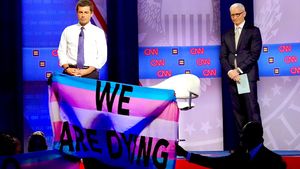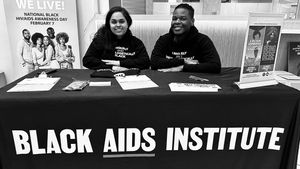GLAAD released its annual State of HIV Stigma report Thursday, which tracks knowledge, attitudes, and sentiment around HIV and HIV stigma across the U.S. Among GLAAD’s findings was that most Americans know something about HIV, Gen Z knows the least out of the generations, and fewer people believe there is stigma around living with HIV.
Keep up with the latest in LGBTQ+ news and politics. Sign up for The Advocate's email newsletter.
“The state of HIV stigma in America could not be more clear: stigma is finally on the decline, and now is the time to accelerate the education that can save lives, through sharing stories of people living with HIV,” Sarah Kate Ellis, president and CEO of GLAAD said.
Stigma around HIV has decreased, but why?
The report, a partnership between GLAAD and Gilead Sciences, found that 85 percent of Americans said they believe HIV stigma exists, down four points from 2020 — more than the margin of error. It also found more and more people know something about HIV.
However, the lack of stigma, GLAAD said, may be due to a lack of awareness around HIV.
“What’s starting to be prevalent now is HIV invisibility,” Jeremiah Johnson, who is living with HIV and is the executive director of the nonprofit organization PrEP4All, told GLAAD in the report. “In some of the most privileged communities, HIV is not as intense and therefore, to them, it no longer exists and is no longer focused on. It’s challenging if you are part of a community that doesn’t have that as your situation and for whom we still need to be doing important awareness raising and policy work.”
And while about 90 percent of Americans said they knew something about HIV, only 37 percent of Gen Z said they were knowledgeable.
Why does Gen Z know the least about HIV?
The report attributed the lack of knowledge on Gen Z’s part to several issues: being born after the early days of the AIDS crisis, seeing less HIV-related stories in media, and also a lack of general access to HIV information than previous generations.
GLAAD, which focuses mostly on LGBTQ+ representation in media, said a decrease in HIV-related stories in media has harmed people being comfortable around those with HIV.
“While this year’s State of HIV Stigma Report reflected a slight uptick in Americans who say they’ve heard of HIV but don’t know much about it — 1 in 10 — GLAAD found that only half of Americans say they feel knowledgeable about HIV, 40 years since the first cases of what later became known as AIDS were officially reported. And, as compared to 2020, more people self-report being uncomfortable interacting with a co-worker or neighbor who was living with HIV,” the report states. “Knowing the power of entertainment media, the loss of stories about HIV can indicate a dangerous backslide at a time when information about the virus is needed most.”
There is a lack of stories about people living with HIV in media
The stories about Americans living with HIV aren’t being told or written, the organization said. GLAAD only counted one character on television living with HIV on broadcast, cable, or streaming scripted primetime programming this year. That’s seven less than last year.
The character? Tim Laughlin (played by Jonathan Bailey) on Fellow Travelers.
Author Ted Kerr told the organization that the stories that include HIV doesn’t have to make the virus the plot point. “It doesn’t necessarily need to be the main character. It doesn’t need to be the main plot line. I think it can be a meaningful thread. You get more bang for your buck when you understand that it is part of the fabric of our lives,” Kerr said.
GLAAD notes that there is evidence that visibility in media can make people more comfortable around those living with HIV — up to 15 percent even. GLAAD attributes fewer stories about those with HIV to a decline in people believing that those with HIV can lead long, healthy lives, which people living with HIV can. Today, those on effective treatment, cannot transmit HIV since the medications suppress the virus. This is the center of the U=U campaign, which underscores that when HIV is undetectable, it is also untransmittable.
“Together with game-changing HIV prevention tools like PrEP and advanced HIV treatment options, we must seize the opportunity before us to close the knowledge gap between generations,” Ellis said. “Ending HIV and HIV stigma should be every generation’s lasting achievement, and we have never been closer to that accomplishment.”





































































